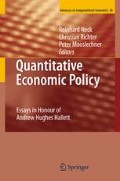Abstract
The primary objective of this paper is the empirical evaluation of the theoretical postulate by Sapir and Sekkat (1999) that the adoption of a single election day throughout the Economic and Monetary Union (EMU) of the European Union (EU) might be welfare improving. They find that the desirability of an electoral area (a common or synchronized election day) between two countries is enhanced when the spillovers between these countries are large and positive, and when they face symmetric shocks. With its asymmetric architecture of economic policy making, EMU is forced by EU law (EC treaty) to coordinate economic (primarily fiscal) policy between its politically independent member states in order not to foil the centralized monetary policy of the ECB. Economic policy coordination is exercised in EMU by a whole range of coordination processes and instruments, of which the Stability and Growth Pact (SGP) is the most prominent one in the field of fiscal policy. As a consequence of economic policy coordination we are already on the right track towards a “European business cycle”. However, as economic policy making (with the exception of monetary policy) is still a competence of the EMU member states, further areas of coordination are welcome. One area where EMU’s member states are still exerting uncoordinated influence (and hence, different shocks) on the economy is the different election dates.
Access this chapter
Tax calculation will be finalised at checkout
Purchases are for personal use only
Preview
Unable to display preview. Download preview PDF.
References
Alesina A (1987) Macroeconomic policy in a two-party system as a repeated game. Quarterly Journal of Economics 102:651–678
Alesina A (1988) Credibility and policy convergence in a two-party system with rational voters. American Economic Review 78:796–805
Alesina A, Roubini N (1992) Political cycles in OECD economies. Review of Economic Studies 59:663–688
Alesina A, Roubini N, Cohen GD (1997) Political cycles and the macroeconomy. The MIT Press, Cambridge MA London
Andrikopoulos A, Loizides I, Prodromidis K (2004) Fiscal policy and political business cycles in the EU. European Journal of Political Economy 20:125–152
Andrikopoulos A, Loizides I, Prodromidis K (2006) Taxation and political business cycles in EU economies. Applied Economics 38:1761–1774
Barro R, Gordon D (1983a) Rules, Discretion and reputation in a model of monetary policy. Journal of Monetary Economics 12:101–121
Barro R, Gordon D (1983b) A positive theory of monetary policy in a natural rate model. Journal of Political Economy 91:589–610
Breuss F (1980) The political business cycle: An extension of Nordhaus’s model. Empirica 7:223–259
Breuss F (2001) Towards a Political Economy of Zero Budgeting in Austria. Empirica 28:41–67
Breuss F (ed) (2007) The Stability and Growth Pact: Experiences and future aspects. Springer, Vienna New York
Buti M, van den Noord (2004) Fiscal policy in EMU: Rules, discretion and political incentives. European Econoy, European Commission, Economic Papers, Brussels 206
Cukierman A, Meltzer AH (1986) A positive theory of discretionary policy, the costs of democratic government, and the benefits of a constitution. Economic Inquiry 24:367–388
Downs A (1957) An economic theory of democracy. New York
Fair RC (1978) The effect of economic events on votes for president. Review of Economics and Statistics 60:159–173
Fair RC (1996) Econometrics and Presidential Elections. Journal of Economic Perspectives 10:89–102
Fair RC (2002) Predicting presidential elections. Stanford University Press, Stanford
Frey BS (1978) Politico-economic models and cycles. Journal of Public Economics 9:203–220
Frey BS, Schneider F (1978a) An empirical study of politico-economic interaction in the United States. Review of Economics and Statistics 60:174–183
Frey BS, Schneider F (1978b) A politico-economic model of the United Kingdom. Economic Journal 88:243–253
Hibbs D (1977) Political parties and macroeconomic policy. American Political Science Review 71:1467–1487
Hibbs D (1987) The American political economy. Harvard University Press, Cambridge MA
Kalecki M (1943) Political aspects of full employment. Political Quarterly 44:322–331
Kydland F, Prescott E (1977) Rules rather than discretion: The inconsistency of optimal plans. Journal of Political Economy 85:473–492
McRae DC (1977) A political model of the business cycle. Journal of Political Economy 85:239–263
Milesi-Ferretti G-M, Perotti R, Rostagno M (2002) Electoral systems and public spending. Quarterly Journal of Economics 117:609–657
Mundell RA (1961) A theory of optimum currency areas. American Economic Review 51:657–665
Nordhaus WD (1975) The political business cycle. Review of Economic Studies 42(2):169–190
Nordhaus WD (1989) Alternative models to political business cycles. Brookings Papers on Economic Activity 2:1–68
Persson T, Tabellini G (1990) Macroeconomic policy, credibility and politics. Harwood Academic Publishers, London
Persson T, Tabellini G (1999) Political economics and macroeconomic policy. In: Taylor JB, Woodford M (eds) Handbook of macroeconomics Vol. 1C. North Holland Elsevier, Amsterdam New York, pp 1397–1482
Rogoff K (1990) Equilibrium political budget cycles. American Economic Review 80:21–36
Rogoff K, Sibert A (1988) Equilibrium political business cycles. Review of Economic Studies 55:1–16
Sapir A, Sekkat K (1999) Optimum electoral areas: Should Europe adopt a single election day? European Economic Review 43:1595–1619
Schumpeter JA (1935) The analysis of economic change. Review of Economic Statistics XVIII:2–10
Author information
Authors and Affiliations
Editor information
Editors and Affiliations
Rights and permissions
Copyright information
© 2008 Springer-Verlag Berlin Heidelberg
About this chapter
Cite this chapter
Breuss, F. (2008). A Common Election Day for Euro-Zone Member States?. In: Neck, R., Richter, C., Mooslechner, P. (eds) Quantitative Economic Policy. Advances in Computational Economics, vol 20. Springer, Berlin, Heidelberg. https://doi.org/10.1007/978-3-540-74684-3_8
Download citation
DOI: https://doi.org/10.1007/978-3-540-74684-3_8
Publisher Name: Springer, Berlin, Heidelberg
Print ISBN: 978-3-540-74683-6
Online ISBN: 978-3-540-74684-3
eBook Packages: Business and EconomicsEconomics and Finance (R0)

